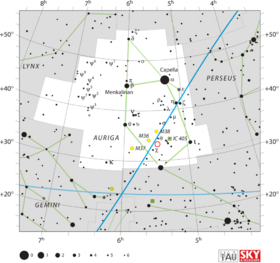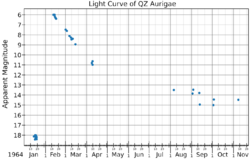Astronomy:QZ Aurigae
| Observation data Equinox J2000.0]] (ICRS) | |
|---|---|
| Constellation | Auriga |
| Right ascension | 05h 28m 34.078s[1] |
| Declination | 33° 18′ 21.78″[1] |
| Apparent magnitude (V) | 5.0Max. 17.0Min.[2] |
| Astrometry | |
| Distance | 3200+4030 −330[2] pc |
| Characteristics | |
| Variable type | Classical Nova, eclipsing binary |
| Other designations | |
Nova Aur 1964, AAVSO 0522+33, Gaia DR2 3449050362952844288[3] | |
| Database references | |
| SIMBAD | data |
QZ Aurigae, also known as Nova Aurigae 1964, was a nova which occurred in the constellation Auriga during 1964. It was discovered by Nicholas Sanduleak on an objective prism photographic plate taken at the Warner and Swasey Observatory on 4 November 1964.[5] Examination of pre-discovery plates from Sonneberg Observatory showed that the eruption occurred in early February 1964, and it had a photographic magnitude of 6.0 on 14 February 1964. Its brightness declined in images taken after the 14th, suggesting that its peak brightness was above 6.0.[6] It was probably visible to the naked eye for a short time.
QZ Aurigae is classified as a "fast nova", because it dropped from peak brightness by three magnitudes in less than 100 days.[7]
All novae are binary stars, with a "donor" star orbiting a white dwarf. The stars are so close to each other that matter from the donor star is transferred to an accretion disk surrounding the white dwarf. Because the separation between the stars is comparable to the radius of the donor star, novae are often eclipsing binaries, and QZ Aurigae shows such eclipses. The depth of the eclipses, 1.2 magnitudes in blue light, is unusually large, indicating that both the white dwarf and the inner accretion disk surrounding it are fully occulted at mid eclipse. The orbital period is 8.58 hours.[8] Schaeffer used small changes in the orbital period, along with other observational data, to derive a mass of 0.98 M☉ for the white dwarf, and 0.93 M☉ for the donor star as well as a mass transfer rate of 3×10−8 M☉ per year.[9] The donor star is a red dwarf with a spectral type of K1.[10]
References
- ↑ 1.0 1.1 Brown, A. G. A. (August 2018). "Gaia Data Release 2: Summary of the contents and survey properties". Astronomy & Astrophysics 616: A1. doi:10.1051/0004-6361/201833051. Bibcode: 2018A&A...616A...1G. Gaia DR2 record for this source at VizieR.
- ↑ 2.0 2.1 Schaefer, Bradley E. (20 September 2018). "The distances to Novae as seen by Gaia". Monthly Notices of the Royal Astronomical Society 481 (3): 3033–3051. doi:10.1093/mnras/sty2388. Bibcode: 2018MNRAS.481.3033S.
- ↑ "QZ Aug". SIMBAD. Centre de données astronomiques de Strasbourg. http://simbad.u-strasbg.fr/simbad/sim-basic?Ident=QZ+Aug.
- ↑ Gessner, H. (September 1975). "Lichtkurve der Nova Aurigae 1964". Zentralinstitut für Astrophysik Sternwarte Sonneberg Mitteilungen ueber Veraenderliche Sterne 7: 45. http://www.sternwarte-sonneberg.de/observatory/images/mvs/volume_07/045.png. Retrieved 21 January 2021.
- ↑ Duerbeck, Hilmar W. (March 1987). "A Reference Catalogue and Atlas of Galactic Novae". Space Science Reviews 45 (1–2): 1–14. doi:10.1007/BF00187826. Bibcode: 1987SSRv...45....1D.
- ↑ Gessner, H. (September 1975). "Nova Aurigae 1964". Information Bulletin on Variable Stars 1042: 1. Bibcode: 1975IBVS.1042....1G.
- ↑ Duerbeck, H.W. (May 1988). "A Reference Catalogue of Galactic Novae". Bulletin d'Information du Centre de Donnees Stellaires 34: 127. Bibcode: 1988BICDS..34..127D.
- ↑ Campbell, R.D.; Shafter, A.W. (February 1995). "A Multicolor Eclipse Study of the Classical Nova QZ Aurigae (Nova Aurigae 1964)". The Astrophysical Journal 440: 336. doi:10.1086/175275. Bibcode: 1995ApJ...440..336C.
- ↑ Schaefer, Bradley E. (March 2020). "Sudden and steady orbital period changes across six classical Nova Eruptions: the end of hibernation and two serious challenges for the magnetic braking model of cataclysmic variable evolution". Monthly Notices of the Royal Astronomical Society 492 (3): 3343–3358. doi:10.1093/mnras/stz3424. Bibcode: 2020MNRAS.492.3343S.
- ↑ Beuermann, K.; Baraffe, I.; Kolb, U.; Weichhold, M. (November 1998). "Are the red dwarfs in cataclysmic variables main-sequence stars?". Astronomy and Astrophysics 339: 518–524. Bibcode: 1998A&A...339..518B.
 |



